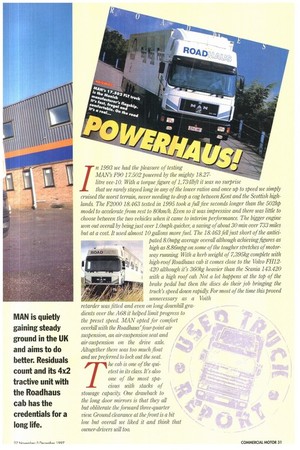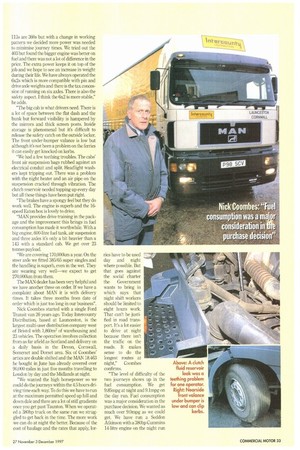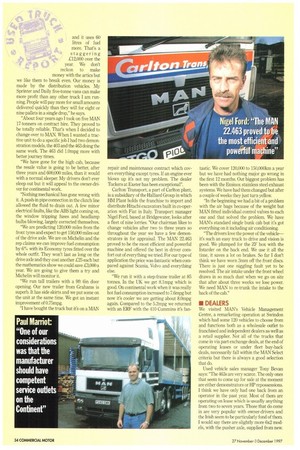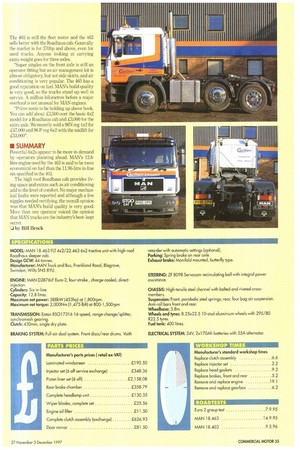MAN is quietly gaining steady ground in the UK and
Page 33

Page 32

Page 34

Page 35

Page 36

Page 37

If you've noticed an error in this article please click here to report it so we can fix it.
aims to do better. Residuals count and its 4x2 tractive unit with the Roadhaus cab has the credentials for a long life.
For years MAN seemed content to bump along about the bottom of the truck sales league but you may have noticed that there are a few more of its trucks running up and down our motorways nowadays. In the past four years the company has doubled its market share from about 4% to over 8% and it is well on target to break through the 10% barrier by the turn of the century To achieve growth in new vehicle sales the product has to be as good, if not better than, the opposition. But there also has to be a sustained market for the used trucks as they come to the end of their first life. First-time buyers are no longer just content for the truck to give good reliability—they want good residuals too. This becomes more difficult as the contract lease market grows, which in turn releases larger numbers of young trucks onto the market.
The second-time buyer also wants value for money as well as reliability. As a manufacturer MAN gave recognition to this fact, with its
In 1993 we had the pleasure of testing MAN 's F90 17.502 powered by the mighty 18.27litre vee-10. With a torque figure of 1,7341bft it was no surprise that we rarely stayed long in any of the lower ratios and once up to speed we simply cruised the worst terrain, never needing to drop a cog between Kent and the Scottish highlands. The F2000 18.463 tested in 1995 took a full five seconds longer than the 5024 model to accelerate from rest to 80km/h. Even so it was impressive and there was little to choose between the two vehicles when it came to interim performance. The bigger engine won out overall by being just over 1.0mph quicker, a saving of about 30 mm over 733 miles but at a cost. It used almost 10 gallons more fuel. The 18.463 fell just short of the anticipated 8.0mpg average overall although achieving figures as high as 8.86mpg on some of the tougher stretches of motorway running With a kerb weight of 7,395kg complete with high-roof Roadhaus cab it comes close to the Volvo FH12420 although it's 360kg heavier than the Scania 143.420 with a high roof cab. Not a lot happens at the top of the brake pedal but then the discs do their job bringing the truck's speed down rapidly For most of the time this proved jilit• ,,unnecessary as a Voith
retarder was fitted and even on long downhill gra dients over the A68 it helped limit progress to the preset speed. MAN opted for comfort overkill with the Roadhaus' four-point air suspension, an air-suspension seat and air-suspension on the drive axle Altogether there was too much float and we preferred to lock out the seat.
The cab is one of the quietest in its class It's also one of the most spacious with stacks of stowage capacity One drawback to the long door mirrors is that they all but obliterate the forward three-quarter view. Ground clearance at the front is a bit low but overall we liked it and think that owner-drivers will too. te) MAN-Select programme introduced at the beginning of this year. It was also a response to actions taken by other
leading manufacturers.
Under the scheme, 13 of MAN's most proactive main dealers in the used truck market, in conjunction with the Vehicle Management Centre at Swindon, offer trucks up to four years old, all subject to stringent mileage limitations. Each vehicle is comprehensively checked and any faulty components are replaced. Each truck is then covered by a minimum three-month comprehensive truck warranty administered by the RAC.
• EVOLUTION
MAN's F2000 range introduced in June 1995 followed behind the F90 Series, making Euro2 engines available well before the October 1996 deadline. Early F2000 trucks could be specified with the then current Euro-1 fivecylinder 10-litre engines rated at 315 and 335hp alongside the six-cylinder 12-litre units at 365 and 394hp before being updated. The more powerful 12.8-litre engine rated at 453hp, developed from the 12-litre unit, was completely new to the range and although about 025 tonnes lighter than MAN's vee-10 could not yet match that engine for ultimate power and torque. Five and six-cylinder engines with electronic management were the result of work started by Bosch a full 10 years ago. Since 1991 EDC has become widely used by European manufacturers and it's said that by the turn of the century 85% of new vehicles will be powered by EDC engines. MAN's F2000s have powerful distributor-type injectors that work at pressures up to 1,000 bar while injector timing and fuel injection rate are controlled precisely to match the imposed loadings.
A new quieter and smoother Eaton 17316 16-speed S series synchromesh box transferred the increase in power down the driveline to a single reduction axle rated at 13 tonnes. MAN's FB standard sleeper cab, revised and improved with twin headlamps and a more rounded profile. was offered alongside the optional high roof Roadhaus cab.
• OPERATORS
MJM Freight Services, based in Redditch, is a family owned business started by managing director Paul Marriot's father in 1982. The company specialises in UK and continental groupage and distribution operating 30 tractive units and three rigids. After a falling out with the local Scania dealer Marriot looked about for an alternative make of truck and last November he took delivery of the first of eight MAN 22.463s.
"Some of our Scanias are 10 years old and this is the first time we have operated new vehicles. It was made possible by moving from a purchasing policy to an operating lease lasting five years. I think we will have had the best out of them by then and it's certainly proving to be the right move at the
moment," he says. "One of our considerations was that the manufacturer should have competent service outlets on the Continent. We have had a lot of bad experiences with foreign repairs in the past. Rates are getting no better so we had to analyse our running costs and we are making savings there. We are responsible for our own maintenance and the trucks are shaping up as we expected. They run fully freighted for most of the time and we are getting fuel figures of between 8.2 and 8.5mpg even running over the mountains into Spain," he continues.
"More and more trucks obtained on lease are already resulting in larger numbers coming back into the used market early Over the next few years this is bound to influence prices. If you are leasing you don't need to worry about the residual values. Our Scania 113s are 360s but with a change in working pattern we decided more power was needed to minimise journey times. We tried out the 403 but found the bigger engine was better on fuel and there was not a lot of difference in the price. The extra power keeps it on top of the job and we hope to see an increase in weight during their life. We have always operated the 6x2s which is more compatible with pin and drive axle weights and there is the tax concession of running on six axles. There is also the safety aspect. I think the 6x2 is more stable," he adds.
"The big cab is what drivers need. There is a lot of space between the flat dash and the bunk but forward visibility is hampered by the mirrors and thick screen posts. Inside storage is phenomenal but it's difficult to release the safety catch on the outside locker. The front under-bumper valance is low but although it's not been a problem on the ferries it can easily get knocked on kerbs.
"We had a few teething troubles. The cabs' front air suspension bags rubbed against an electrical conduit and split. Headlight washers kept tripping out. There was a problem with the night heater and an air pipe on the suspension cracked through vibration. The clutch reservoir needed topping up every day but all these things have been put right, "The brakes have a spongy feel but they do work well. The engine is superb and the 16speed Eaton box is lovely to drive.
"MAN provides drive training in the package and the improvement this brings in fuel consumption has made it worthwhile. With a big engine, 600-litre fuel tank, air suspension and three axles it's only a bit heavier than a 143 with a standard cab. We get over 23 tonnes payload.
"We are covering 170,000Icm a year. On the steer axle we fitted 385/65 super singles and the handling is superb, even in the wet. They are wearing very well—we expect to get 270,0001cm from them.
The MAN dealer has been very helpful and we have another three on order. If we have a complaint about MAN it is with delivery times. It takes three months from date of order which is just too long in our business".
Nick Coombes started with a single Ford Transit van 26 years ago. Today Intercounty Distribution, based at Launceston, is the largest multi-user distribution company west of Bristol with 1,860m2 of warehousing and 23 vehicles. The operation involves collection from as far afield as Scotland and delivery on a daily basis in the Devon, Cornwall, Somerset and Dorset area. Six of Coombes' artics are double shifted and the MAN 18.463 he bought in June has already covered over 90,000 miles in just five months travelling to London by day and the Midlands at night.
We wanted the high horsepower so we could do the journeys within the 4.5 hours driving time each way To do this we have to run at the maximum permitted speed up hill and down dale and there are a lot of stiff gradients once you get past Taunton. When we operated a 380hp truck on the same run we struggled to get back in the time. The more work we can do at night the better. Because of the cost of haulage and the rates that apply, lor ries have to be used day and night where possible. But that goes against the social charter the Government wants to bring in which says that night shift workers should be limited to eight hours work. That can't be justified in road transport. It's a lot easier to drive at night because there isn't the traffic on the roads. It makes sense to do the longest routes at night," Coombes confirms.
"The level of difficulty of the two journeys shows up in the fuel consumption. We get 9.85mpg at night and 9.1mpg on the day run. Fuel consumption was a major consideration in the purchase decision. We wanted as much over 9.0mpg as we could get. We have run a Seddon Atkinson with a 380hp Cummins 14-litre engine on the night run and it uses 60 litres of fuel more. That's a staggering £12,000 over the year. We don't reckon to make money with the artics but we like them to break even. Our money is made by the distribution vehicles. My Sprinter and Daily five-tonne vans can make more profit than any other truck I am running. People will pay more for small amounts delivered quickly than they will for eight or nine pallets in a single drop," he says.
"About four years ago I took on five MAN 17-tonners on contract hire. They proved to be totally reliable. That's when I decided to change over to MAN. When I wanted a tractive unit to do a specific job! had two demonstration models, the 403 and the 463 doing the same work. The 463 did 1.0mpg more with better journey times.
"We have gone for the high cab, because the resale value is going to be better, after three years and 600,000 miles, than it would with a normal sleeper. My drivers don't ever sleep out but it will appeal to the owner-driver for continental work.
"Nothing mechanical has gone wrong with it. A push-in pipe connection in the clutch line allowed the fluid to drain out. A few minor electrical faults, like the ABS light coming on, the window tripping fuses and headlamp bulbs blowing, largely corrected themselves.
We are predicting 120,000 miles from the front tyres and expect to get 150,000 miles out of the drive axle. We are on Michelin and the rep claims we can improve fuel consumption by 6% with its Economy tyres fitted over the whole outfit. They won't last as long on the drive axle and they cost another £25 each but the mathematics show we could save £3,000 a year. We are going to give them a try and Michelin will monitor it.
"We run tall trailers with a 9ft fin door opening. Our new trailer from Grahams is superb. It has side skirts and we put some on the unit at the same time. We got an instant improvement of 0.75mpg.
"I have bought the truck but it's on a MAN repair and maintenance contract which covers everything except tyres. If an engine ever blows up it's not my problem. The dealer Tuckers at Exeter has been exceptional".
Carlton Transport, a part of Canton plant, is a subsidiary of the Halliard Group in which BM Plant holds the franchise to import and distribute Hitachi excavators built in co-operation with Fiat in Italy. Transport manager Nigel Ford, based at Bridgewater, looks after a fleet of nine lorries. "Our chairman likes to change vehicles after two to three years so throughout the year we have a few demonstrators in for appraisal. The MAN 22.463 proved to be the most efficient and powerful machine and offered the best in driver comfort out of everything we tried. For our type of application the price was fantastic when compared against Scania, Volvo and everything else.
"We run it with a step-frame trailer at 85 tonnes. In the UK we get 8.1mpg which is good. On continental work when it was really hot fuel consumption increased to 7.6mpg but now it's cooler we are getting about 8.0mpg again. Compared to the 52mpg we returned with an ERF with the 410 Cummins it's fan tastic. We cover 120,000 to 150,000km a year but we have had nothing major go wrong in the first 12 months. Out biggest problem has been with the Eminox stainless steel exhaust systems. We have had them changed but after a couple of weeks they just turn yellow.
"In the beginning we had a bit of a problem with the air bags because of the weight but MAN fitted individual control valves to each one and that solved the problem. We have MAN's standard single bunk cab but it's got everything on it including air conditioning.
"The drivers love the power of the vehicle— it's such an easy truck to drive and vision is good. We plumped for the ZF box with the Intarder on the back end. We use it all the time, it saves a lot on brakes. So far I don't think we have worn 3mm off the front discs. There is just one niggling fault yet to be resolved. The air intake under the front wheel draws in so much dust when we go on site that after about three weeks we lose power. We need MAN to re-trunk the intake to the back of the cab."
• DEALERS
We visited MAN's Vehicle Management Centre, a remarketing operation at Swindon which had some 120 vehicles to choose from and functions both as a wholesale outlet to franchised and independent dealers as well as a retail supplier. Not all of the trucks that come in via part exchange deals, at the end of operating leases or under fleet buy-back deals, necessarily fall within the MAN Select criteria but there is always a good selection that do.
Used vehicle sales manager Tony Bevan says: "The 463s are very scarce. The only ones that seem to come up for sale at the moment are either demonstrators or HP repossessions. I think we have only had one back from an operator in the past year. Most of them are operating on lease which is usually anything from two to seven years. Those that do come in are very popular with owner-drivers and the Irish seem to be particularly fond of them. I would say there are slightly more 6x2 models, with the pusher axle, supplied from new. The 403 is still the fleet motor and the 463 sells better with the Roadhaus cab. Generally the market is for 370hp and above, even for used trucks. Anyone looking at carrying extra weight goes for three axles.
"Super singles on the front axle is still an operator fitting but an air management kit is almost obligatory, but not side skirts, and air conditioning is very popular. The 465 has a good reputation on fuel. MAN's build quality is very good, so the trucks stand up well in service. A million kilometres before a major overhaul is not unusual for MAN engines.
"Prices seem to be holding up above book. You can add about .0,500 over the basic 4x2 model for a Roadhaus cab and £3,000 for the extra axle. We recently sold a 96N reg 4x2 for £47,000 and 96 P reg 6x2 with the midlift for £53,000".
• SUMMARY
Powerful 6x2s appear to be more in demand by operators planning ahead. MAN's 12.8litre engine used by the 463 is said to be more economical on fuel than the 11.96-litre in-line six specified in the 403.
The high roof Roadhaus cab provides living space and extras such as air conditioning add to the level of comfort. No major mechanical faults were reported and although a few niggles needed rectifying, the overall opinion was that MAN's build quality is very good. More than one operator voiced the opinion that MAN trucks are the industry's bestkept secret.
LI by Bill Brock
SPECIFICATIONS
MODEL: MAN 18 463 FIT 4x2/22.463 6x2 tractive unit with high-roo; Roadhaus sleeper cab. Design GCW: 44 tonnes. Manufacturer: MAN Truck and Bus, Frankland Road, Blag rove, Swindon, Wilts SN5 8YU.
ENGINE: MAN D2876LF Euro-2, four-stroke , charge-cooled, direct
injection.
Cylinders: Six in-line. Capacity: 12.8 litres.
Maximum net power: 388kW (453hp) at 1,800rpm. Maximum net torque: 2,000Nm 11,475 lbfl) at 800-1,50Orpm TRANSMISSION: Eaton R5017316 16-speed, range-change/splitter, synchromesh gearing. Clutch: /430mm, single dry plate.
BRAKING SYSTEM: Full-air dual system. Front discs/rear drums. Voith retarder with automatic settings (optional). Parking: Spring brake on rear axle.
Exhaust brake: Manifold mounted, butterfly type.
STEERING: ZF 8098 Servocom recirculating bail with integral power assistance.
CHASSIS: High-tensile steel channel with bolted and riveted crossmembers.
Suspension: Front, parabolic steel springs; rear, four bag air suspension. Anti-roll bars front and rear.
Wheelbase: 3.8m.
Wheels and tyres: 8.25x22.5 10-stud aluminium wheels with 295/80 R22.5 tyres. Fuel tank: 400 litres.
ELECTRICAL SYSTEM: 24V, 2x1704 batteries with 55A alternator.
PARTS PRICES
Manufacturer's ports prices ( retail ex-VAT) Laminated windscreen £190.50 Injector set 16 off service exchange) £348.36 Piston liner set 16 off) £2,158.08 Rear brake chamber £358.79 Complete headlamp unit £130.35 Wiper blades, complete set £25.56 Engine all filter £11.50
Complete clutch assembly (exchange)
£626.93
Door mirror
£81.50 WORKSHOP TIMES
Manufacturer's standard workshop times
Replace clutch assembly 66
Replace injector set 2 2
Replace head gaskets 9 2
Replace brakes, front and rear 5 2 Remove and replace engine 19.1 Remove and replace gearbox 6 2
ROADTESTS
Euro 2 group test 7.9.95 MAN 18.463 14.9.95 MAN 18.403 95.96








































































































